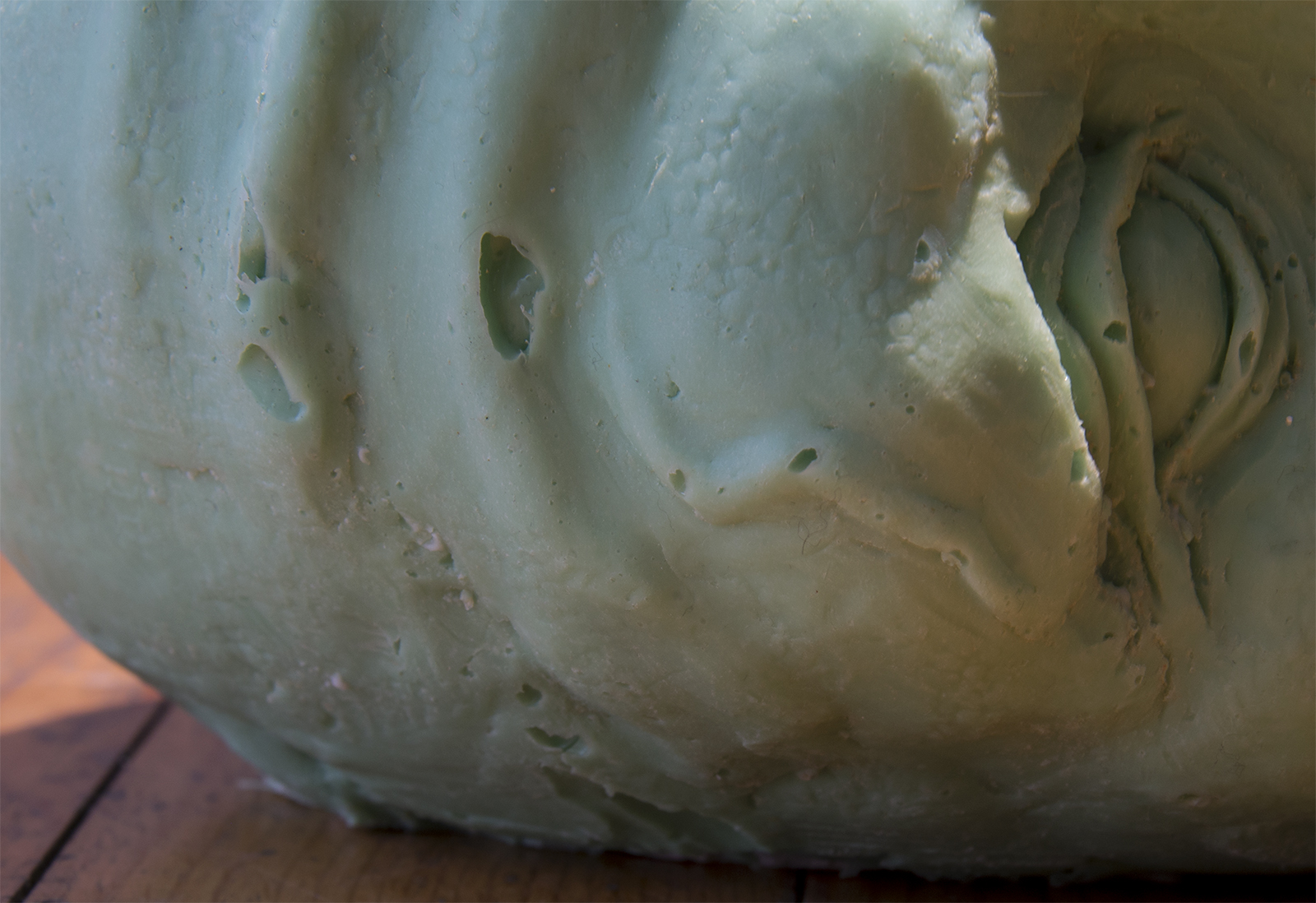
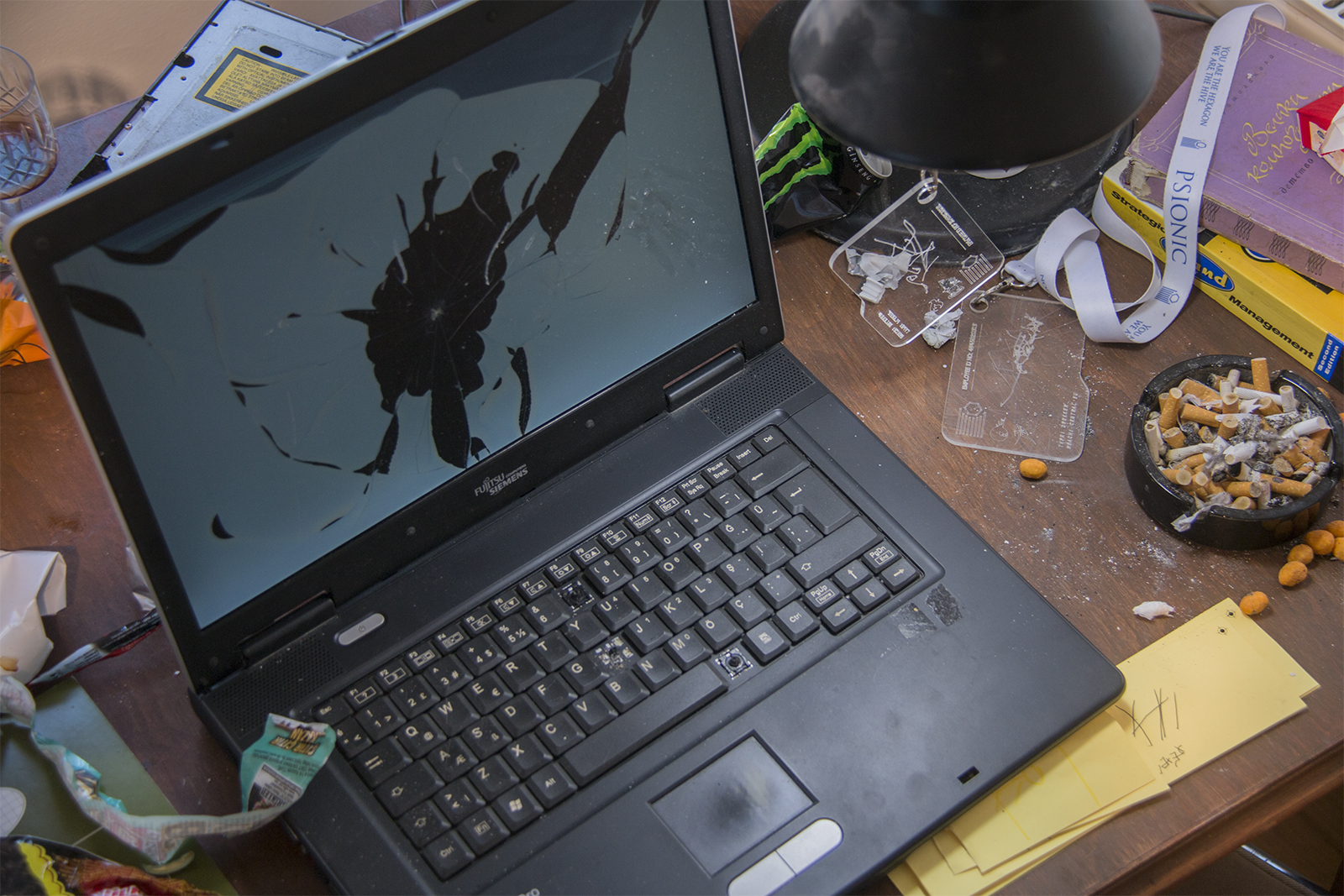
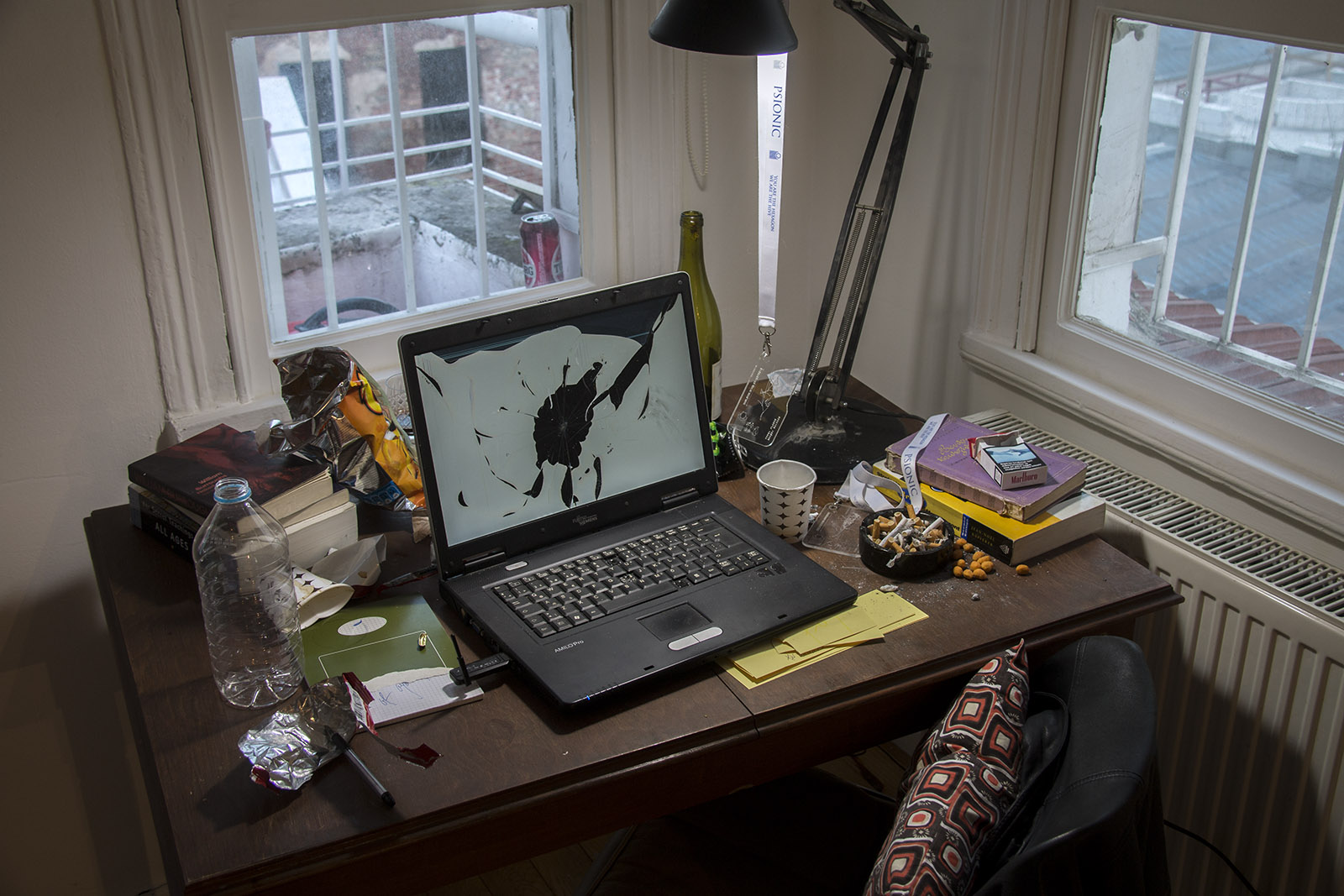
Bora Akinciturk & Berk Cakmakci
desk, 2017
site specific installation
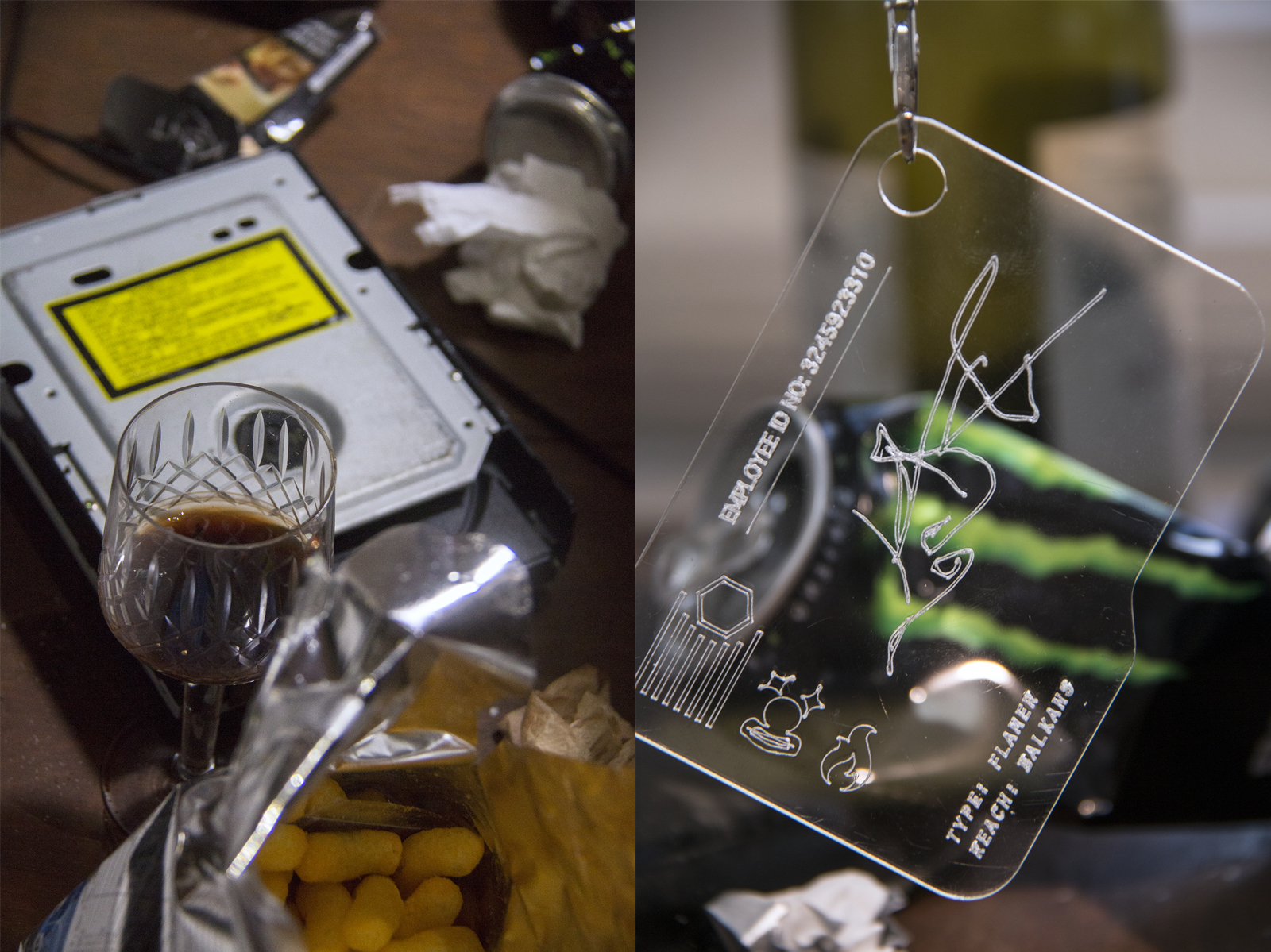
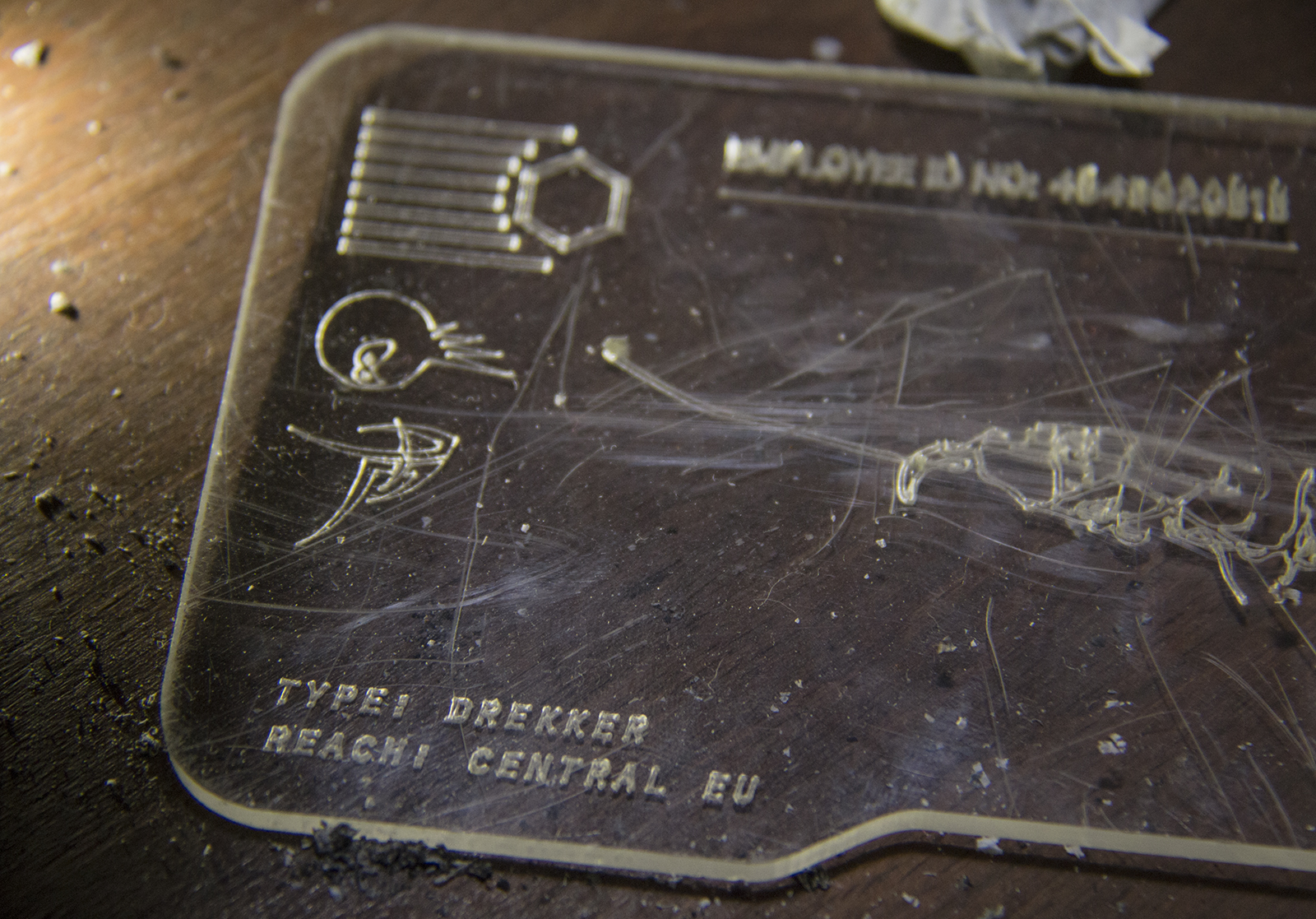
Bora Akinciturk & Berk Cakmakci
desk, detail, 2017; psionic ID Card (Flamer), 2017 and psionic ID Card (Drekker), detail, 2017
custom laser engraved and cut plexi
Berk: Bora and I had been wanting to collaborate visually for some time. We were in a group show together with eight other artist back in 2012, and made music together on and off throughout the years. Even though we were in different parts of the world for most of the time, we kept bouncing ideas back and forth online. When Bora was approached by OJ, he asked if I wanted to work together on a duo show. It ended up being a fully collaborative project apart from my video, “Give violence a chance”, and Bora’s painting “Fuck you to all the people who didn’t believe in me”. All the rest was made as a duo.
Bora: Almost all of our collaborations with Berk before “Curtain of Like” were actually the two of us spending hours on perfecting what we wanted to produce. We are both similarly obsessive about what we want. The initial idea for the show was to use only cheap print shops in Istanbul, and to limit our production to that. So the concept of the show would be in relation to the way it was produced but during that decision stage we came across this article about a Russian troll house, and since OJ is an apartment flat which kind of motivates artists to use it as a site specific platform, we decided to turn it into an abstraction of an abandoned “troll house”.
Berk: It would be a place where people churn out fake news, provocative comments, memes etc all day and do it on a payroll. We created Psionic, which is an all-seeing, panopticon-like faceless corporation specialising in disinformation tactics. The concept evolved from there, becoming even more absurd with one of the employees ending up mutating into a real troll and getting decapitated. During conceptualisation and production, the satire of the current state of media and the darkness that’s looming on the horizon bled into each other, blurring the line between the two.
Berk: I imagine Psionic as Anonymous and Starbucks collapsing into each other. Where the communal approach and dedication of an underground organization, and the reach and machine-like precision of a successful brand intertwine. The ID card is almost like a badge of honor, proving that the employee actually is part of something. A tangible way of making yourself feel better about the things you have to do or forced to do in order to make a living. It’s a leash. I think the concept of being an individual vs being part of something bigger lies within the discourse of online interactions. The dynamics of social media is structured around that very contradiction. I interpret the text for the show as cold and overbearing. Creating a sense of faux-belonging to a so-called greater whole, that in truth operates as a multinational capitalist corporation.
Bora: I totally agree with Berk and find artworks that comment on contemporary life in the most honest way to generally be the more dark and nihilistic ones. That is tied directly to my current worldview of course but I think it’s also related to what is true and horrible about human nature. The fact that Psionic is not entirely fantastical makes it more scary and threatening.
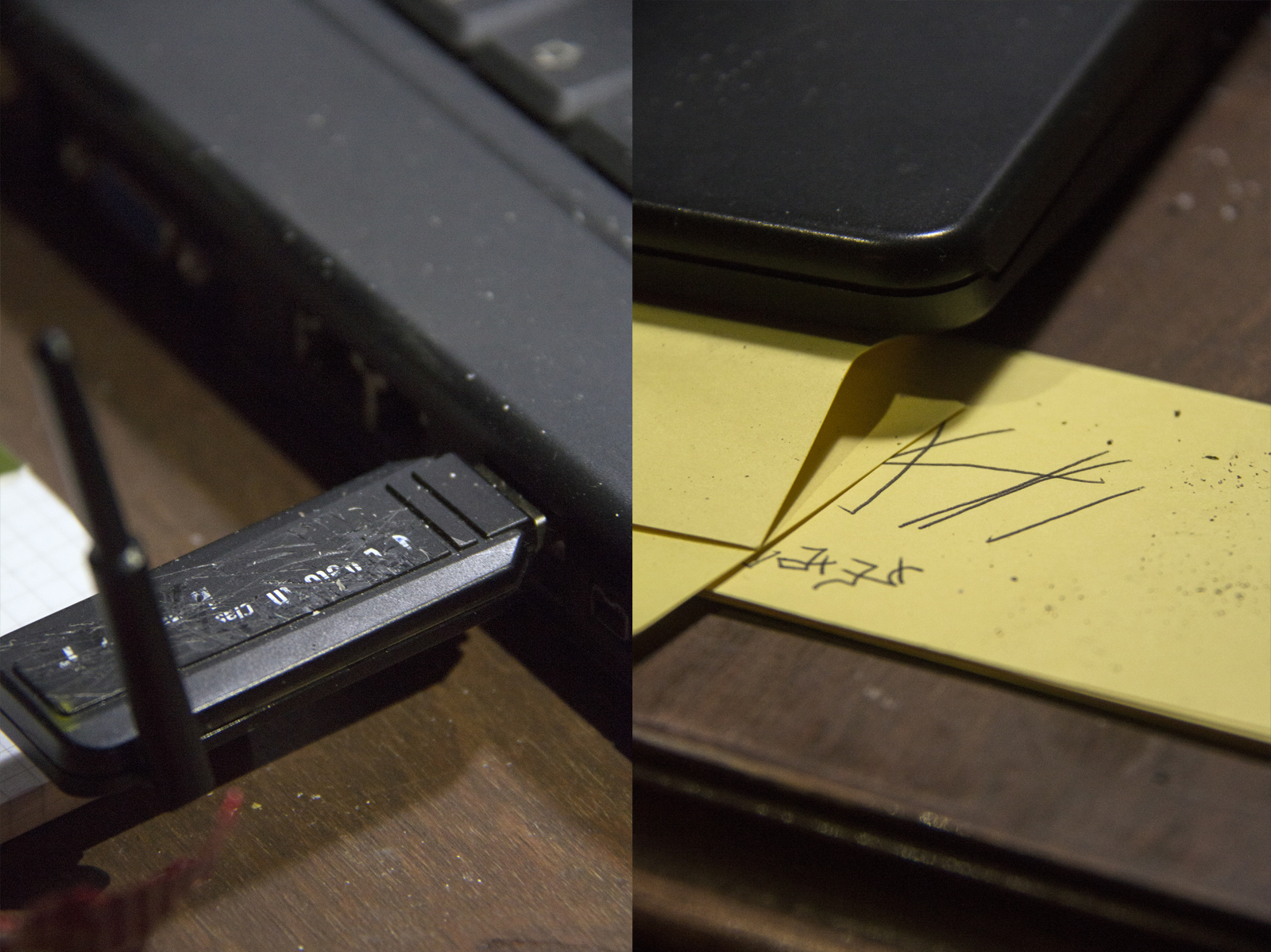
Bora Akinciturk & Berk Cakmakci
desk,details, 2017
site specific installation
Bora: I do feel the world we live in is weird and unreal and I am deeply interested in the strange memetic dark corners of 4chan and reddit and concerned about all the horrifying, depressing political and social events but I don’t see humanity capable of figuring out any of the big philosophical questions quite yet. Rather I think all this weirdness, violence and stupidity are signs of a boiling point in the ongoing human evolution, maybe the beginning of that certain transformation that would turn us into post-humans in the end.
Swedish philosopher Nick Bostrom’s Simulation Argument has been an inspiration for me conceptually ever since I first came across it about five years ago. I find the concept of alternate realities close to Bostrom’s argument in some ways. But I don’t think if we were living in some kind of post-human made ancestral simulation and it is actually the year 42069 there would be any way of waking up from it. The complexity of the simulation would overrule any kind of digital resistance.
Berk: I consider myself moderately tech savvy, but I still can’t fully understand the inner workings of online communication. Even though it’s not as mystical as it used to be, internet is still magical to me because of that. That’s why I think Psionic as a brand name works on two different levels, as this Blade Runner-esque, distant-future corporation, also as a techno-occult practice, possibly a spiritual outlet for the disenfranchised youth of tomorrow, however sad it may sound. So yes, thinking about the unknown and the incomprehensible rifts in technology had a significant influence on us in the show.
Bora: I had no initial conceptual reason for using Pepe specifically for that painting other than my general interest in memes and in their aesthetics. The first idea was to build a vague narrative using a clipart character of a cigarette running around happily on a street full of cigarette butts. Also I had found a tiny cartoon-like figure of a snowman at my parent’s flat around the same time and it got me thinking that the clipart cigarette running around cigarette butts and a snowman walking on that same street on a sunny day would work creating an absurd composition. At some point I needed a third character doing something behind a curtain or a wall for the top left side of the painting. I was going through a folder of rare Pepe images and I remember seeing one with cum on its face. I found its expression interestingly vacant, I wasn’t sure if it was proud or ashamed by it, enjoying it or hating it.. It was a triggering kind of image but not in favor of a certain statement. And I find it silly that Pepe the Frog is considered to be a hate symbol mainly because before all this sensitivity Pepe or Wojak/That Feel Guy or Trollface were just memes satirically reflecting certain feelings and aesthetics. Sometimes they were really dark feelings and bleak aesthetics and sometimes they were funny and superficial and some were motivating and sometimes they were deeply philosophical. But they did not serve any one ideology or had a singular identity. That always made me think that the frog (blank Pepe) was like a mirror where you could project whatever ideology, identity or image you wanted. I think what I’m trying to say is that I understand it could be very irritating when a certain meme is used by a hate group and it becomes their contemporary political propaganda tool but I don’t think labelling the character/meme as a “hate symbol“ resolves anything. On the contrary this kind of mentality complicates the issue, dragging it away from any potential solution.
Berk: I first became aware of the fascist (or the so-called alt-right) connotations of Pepe the Frog after the Richard Spencer punching video. I didn’t know it was being used as a hate symbol to be honest. That’s my illiteracy in meme culture, but I’m sure there were a lot of people who had no idea what that poorly drawn anthropomorphic frog implicates. That doesn’t change anything though. It’s nothing new. Disgusting ideologies have been attached to certain symbols, and used dangerously throughout human history. However, what else is also dangerous is to build a barrier, forbidding art from questioning, dismantling, mocking or discussing the ways in which the image of Pepe and the like operate.
When an artwork functions only as propaganda, it’s not interesting to me. I find it hard to engage with it beyond the surface. In the case of Bora’s painting I see Pepe as the comic relief and in the light of current political context of things, it gains new meaning, to me it becomes a disarming image. The “white man” is headless, without a name, and the ejaculation cheapens the toxic ideas Pepe has come to represent. That to me is how you properly piss off straight, white-nationalist Nazi scum. In the broader context of the show, it reveals how fragile the politics of internet culture are. How quickly an image with no real intellectual weight can transform into a hate symbol.
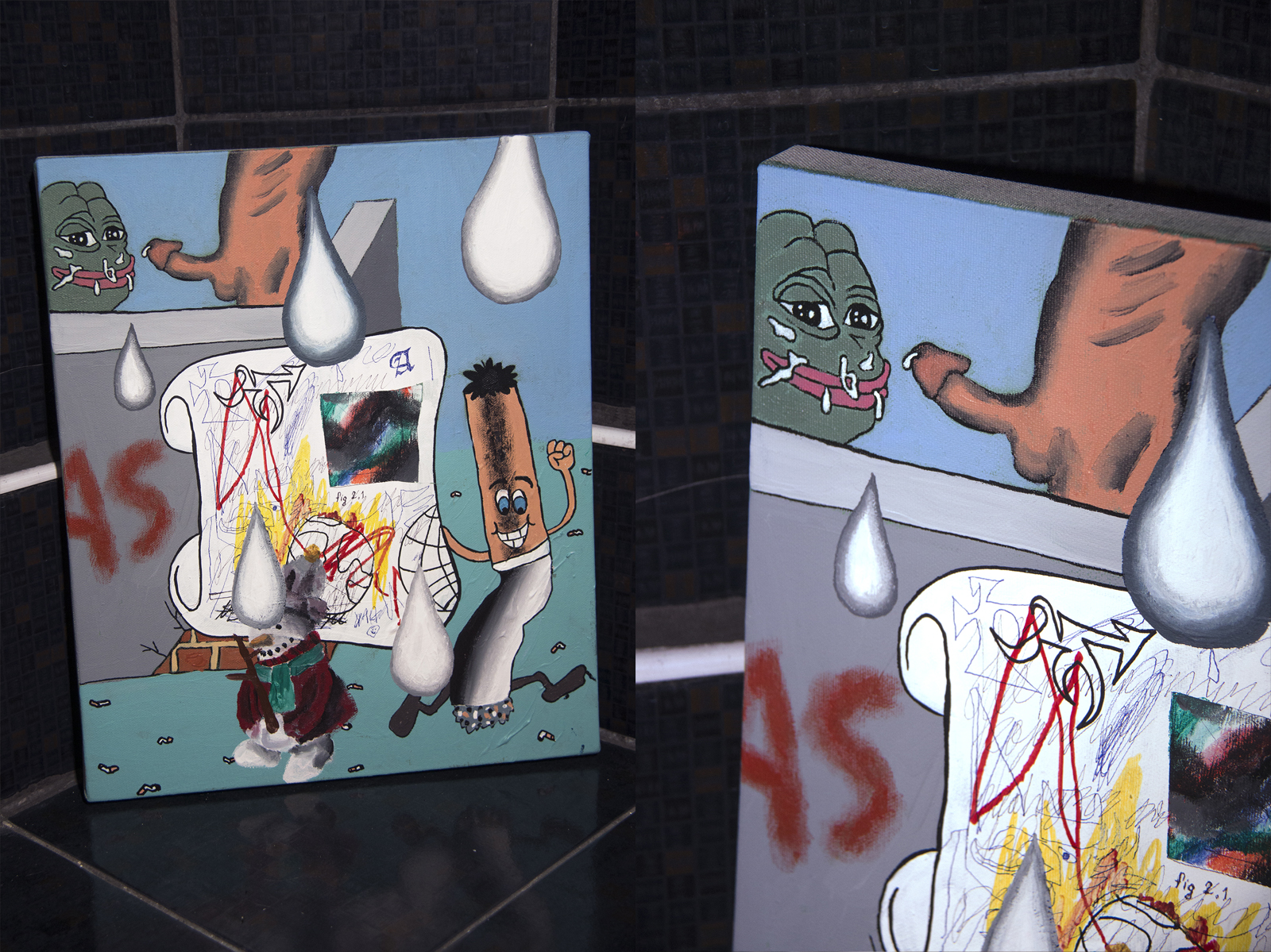
Bora Akinciturk
fuck you to all the people who didn’t believe in me, 2016
acrylic, permanent marker and pen on canvas
32x38cm
Bora: I have been mostly feeling morally and politically dead inside for a while now in relation to all these events. The feeling that everything is rotten and past the point of saving. The feeling that there’s nothing I can do except maybe hit the share button or write some emotional Facebook post. This feeling of pointlessness makes me want to disappear feeling shame and inadequacy. And the worst part is after a certain amount of time everything gets back to “normal” and we go back to our day jobs and go back to feeling ok..
I spent almost all of 2016 in Istanbul for a solo show which never happened mainly due to the Turkish coup attempt, the many attacks in Istanbul and around the country and the economical instability. Inescapably it affected the way I live and produce work but it still was a productive year and having that motivation is one of the most important things for me.
A strange thing we’ve noticed first hand while setting up the show in Asmali Mescit (a part of Taksim Square which was once the most lively, crowded and colourful area with a lot of bars and venues) was that it had turned into a zombie apocalypse kind of lifeless environment with the only habitants being police officers. It was a depressing sight to witness, actually seeing that area’s transformation and at the same time it was the perfect dystopian setting for the vague narrative of our show.
Berk: It’s like trying to balance on a ball. 2016 was a horrible year, not just for Turkey but pretty much for every other country. It affects me deeply. It definitely changed how I sleep, how I work, where I feel safe, what I watch and listen to. It also made me more careless, in a good way. I feel more confident jumping into situations I’m not too familiar with. That’s my way of trying to find comfort in all the chaos, keeping busy. I can say that the political climate contributed to the show through the combined feeling of terror, anxiety, anger, hopelessness and inevitable irony.
I don’t have a first-hand experience with living in the UK after Brexit, or in the USA after Trump’s election. But a significant number of people in Turkey have been living in an extremely turbulent, unsafe environment for almost a decade. There’s no freedom of press to talk about. Most of the news sources are eradicated because of their anti government views and almost all of the remaining outlets have become their propaganda tool. This has a long history but it’s gotten to a point where it can be against the law to do fact-based journalism. Sadly, government-sponsored news is what most people have access to.
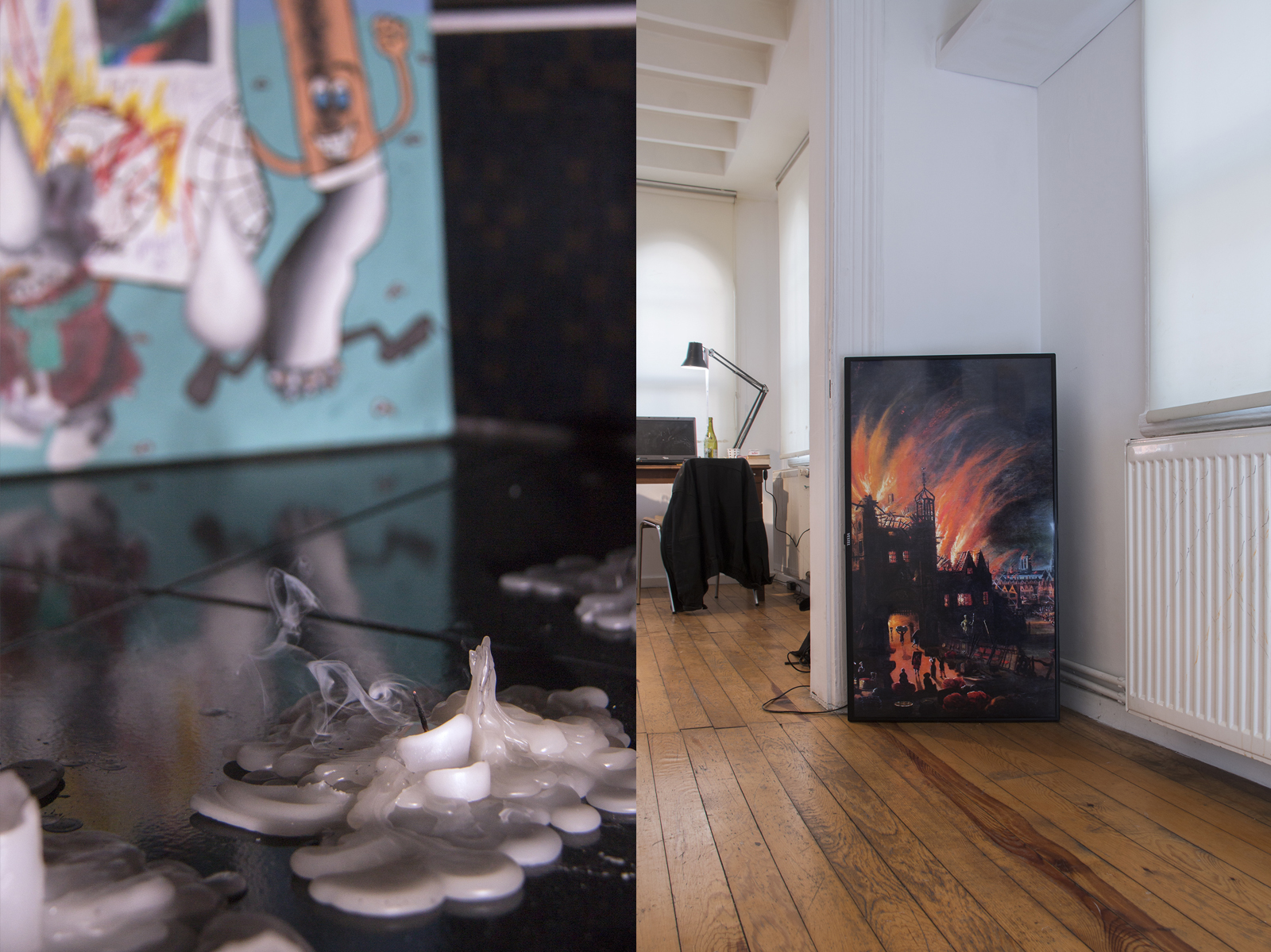
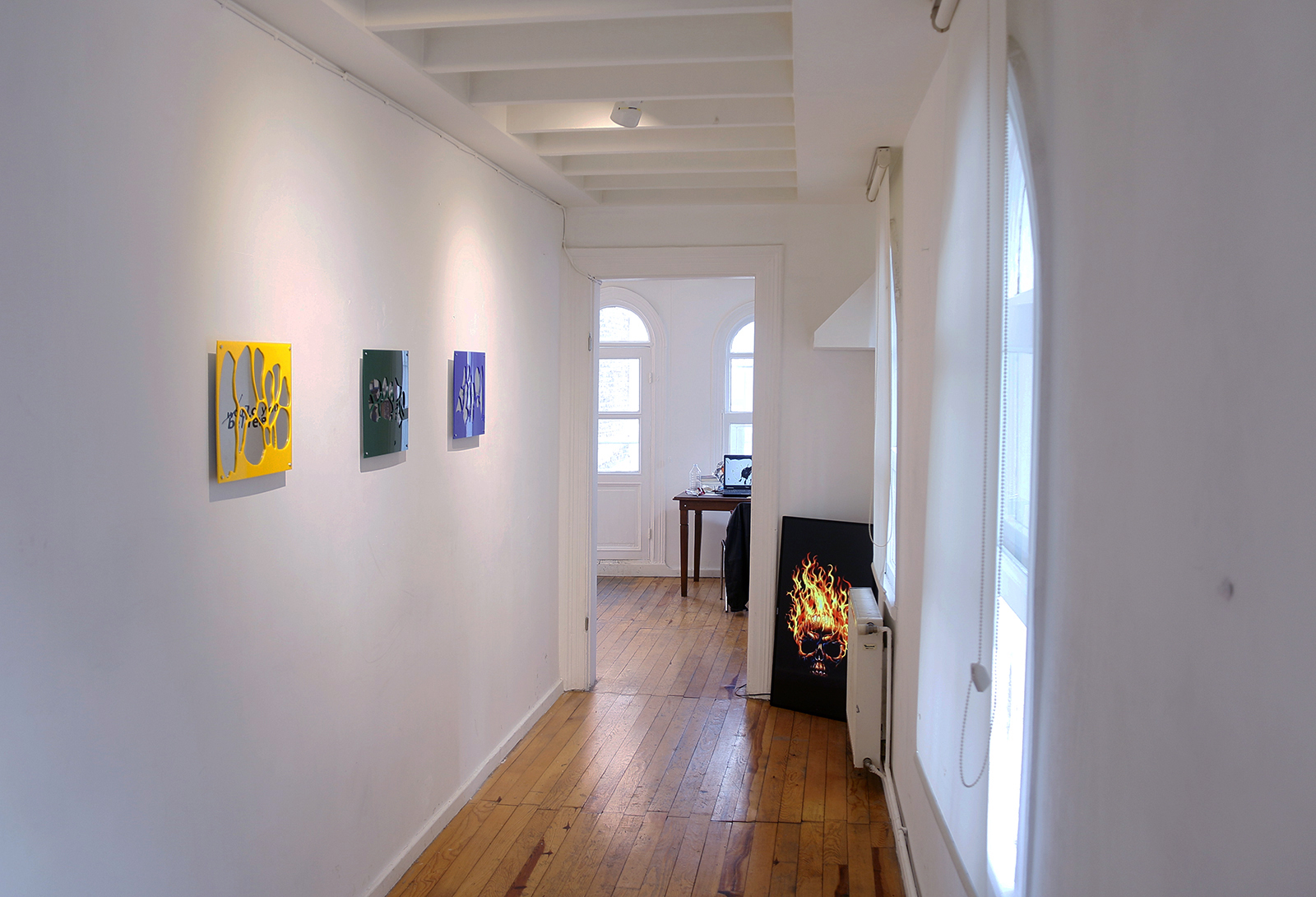
Bora Akinciturk
fuck you to all the people who didn’t believe in me, 2016
acrylic, permanent marker and pen on canvas
32x38cm
Berk Cakmakci
give violence a chance, 2017
HD video, duration: 1:26
The antithesis is maybe a kind of nihilistic disregard for everything. Today this likely manifests as trolling, an activity which is often extremely distasteful, hurtful and offensive. Trolling has been used to target and harass certain groups, identities and individuals, memes have been co-opted by hate groups moving from irony to actuality . Trolling is now used as a political weapon, memes have become a virulent form of potent neo-propaganda and troll factories exist in Russia and Macedonia to destabilise and influence the balance of world power. However trolling can also be used positively, consciously and ethically to undermine and dismantle a rigid system and mock its rules ; The Jogging & UV Production House certainly did so with Art.
Whats-more, as Artist’s it can increasingly feel as though our agencies are being threatened, dismantled and exploited at best, as it becomes harder and harder to make a living or maintain a decent standard of life under these conditions. Creating works that merely ‘comment’ on the contemporary moment can feel alienating, impotent and detached. It seems as though much of this sense of disillusion is expressed in ‘Curtain of Like’ along with a wider dissatisfaction with contemporary life, instilling a desire for something else. So I guess my question is, how do you feel about this? And do you think that the Art which is being made today is in some ways starting to act in accordance with a kind of breaking down and dismantling from the bottom up. So as it becomes more and more difficult to instrumentalise Art as an instrument of cultural power and wealth would you agree that the job of Art is perhaps to increasingly to undermine, dismantle and derobe?
Bora: I definitely feel dissatisfied with how the art world has failed artists and operates in a classically boring strictly capitalist system but I still have desire to produce work. Those two are essentially separate for me. Along the borders of subjective appreciation I also find most socio-political conceptual Art to have a hard time being honest with itself. I think human communication, although we think is currently at its finest, is still fundamentally primitive. We visualise and contextualise our thoughts linearly, use a narrow palette of feelings describing things and have limited disarrangement methods. Art is interesting at this point because it is a whole different breed/device of communication and has a stranger level and power of connection with its observers. Although most contemporary Art may be stale trying to pose as a certain brand, reflect a specified image/ideology in exclusive, wealthy and hierarchical art scenes/circles, it still has the power to destruct these same conditions which stand problematic.
Berk: Like Bora, I think we’re still trying to figure out the best way to communicate, be it through Art, Politics or advancements in technology. Unfortunately we don’t seem to know where we’re headed. We’re nowhere near of formulating an adequate strategy or a tool yet. Navigating through endless information is extremely tiring. Making sense of it is too. Trolling is just another buzzword, an attempt at understanding what technology actually does to us. Humans have always been deceitful, sly, and rude. Trolling is the expression of those same traits on the internet, with the screen acting as a shield hiding one’s actual intentions. We don’t really know if we truly understand each other even though we seem constantly “connected”. It’s very disappointing. I think that’s the reason why I feel dissatisfied with contemporary life. As we’re experiencing it with our online identities, altering or mutating the real can reveal to us strange and sometimes scary new sides to our personalities. So Art is trying to adjust to this mess as well. It fails most of the time, but it doesn’t mean we should stop trying. Reality sneaks into Art in myriad ways. At times the outcome has intellectual and emotional depth, and other times reality manifests itself in the form of corporate sponsorship, poor judgement or simply bad taste.
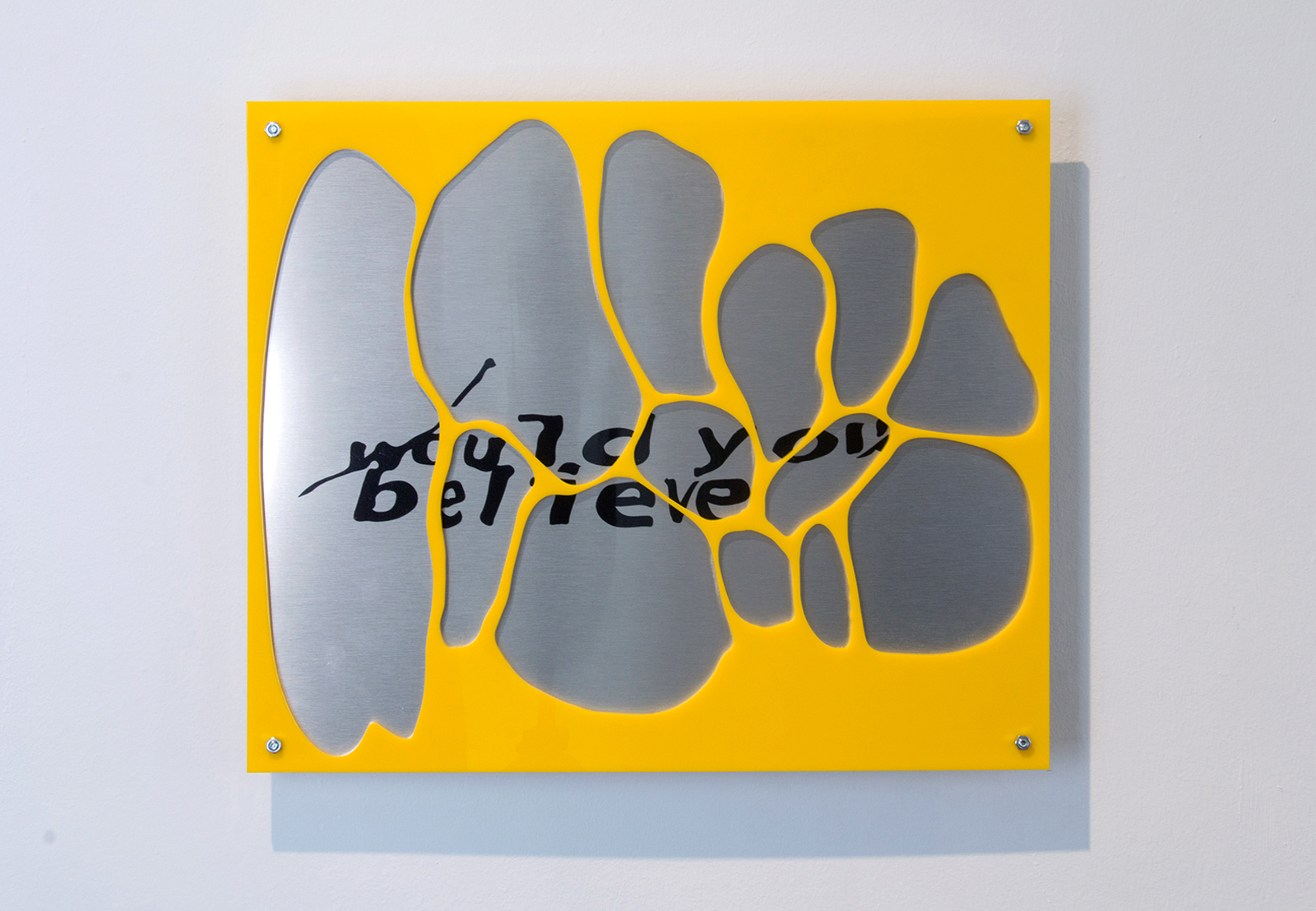 Bora Akinciturk & Berk Cakmakci
Bora Akinciturk & Berk Cakmakci
would you believe, 2017
laser cut plexi and sublimation print on aluminum
30x38cm
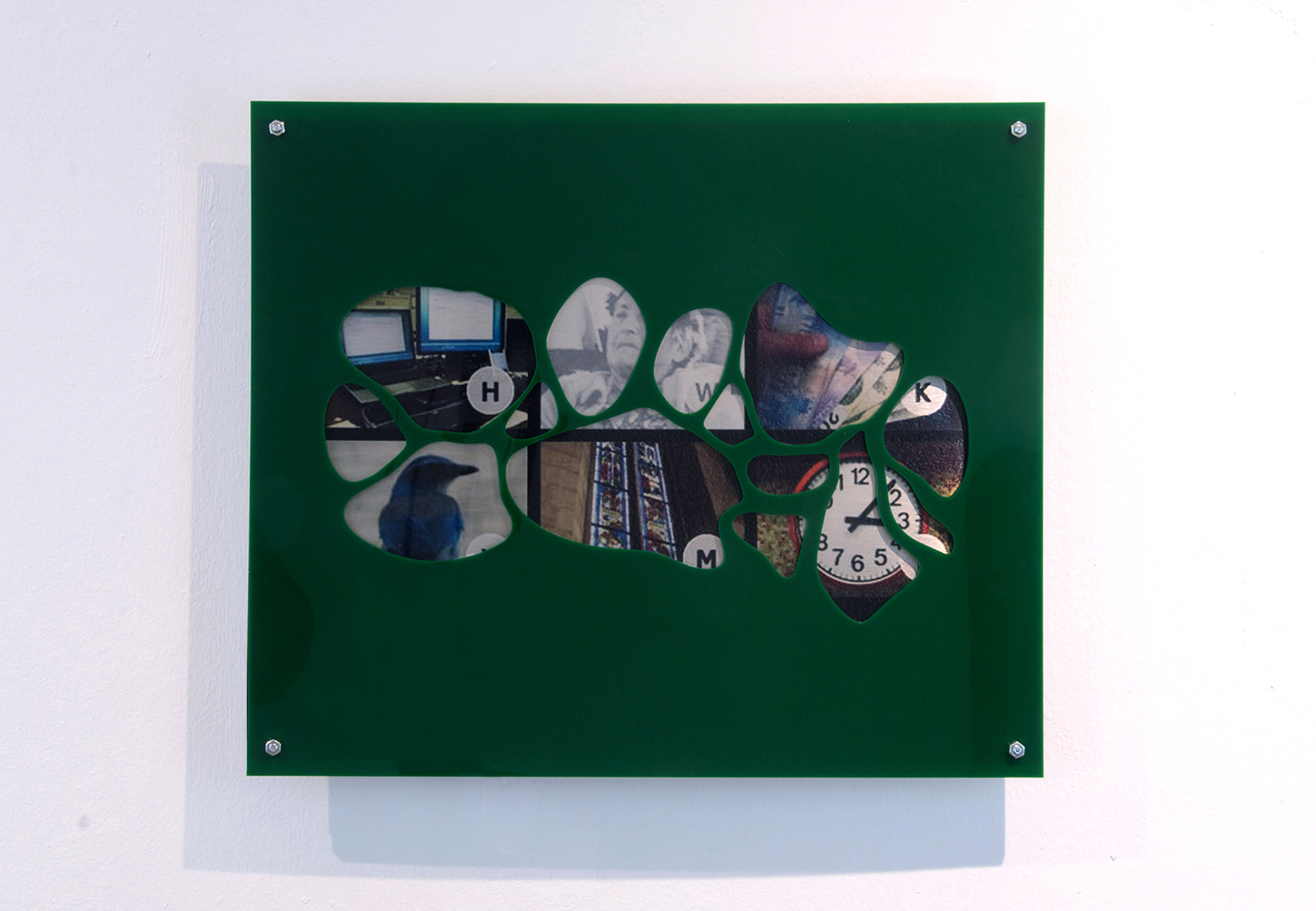 Bora Akinciturk & Berk Cakmakci
Bora Akinciturk & Berk Cakmakci
click the person, 2017
laser cut plexi and sublimation print on aluminum
30x38cm
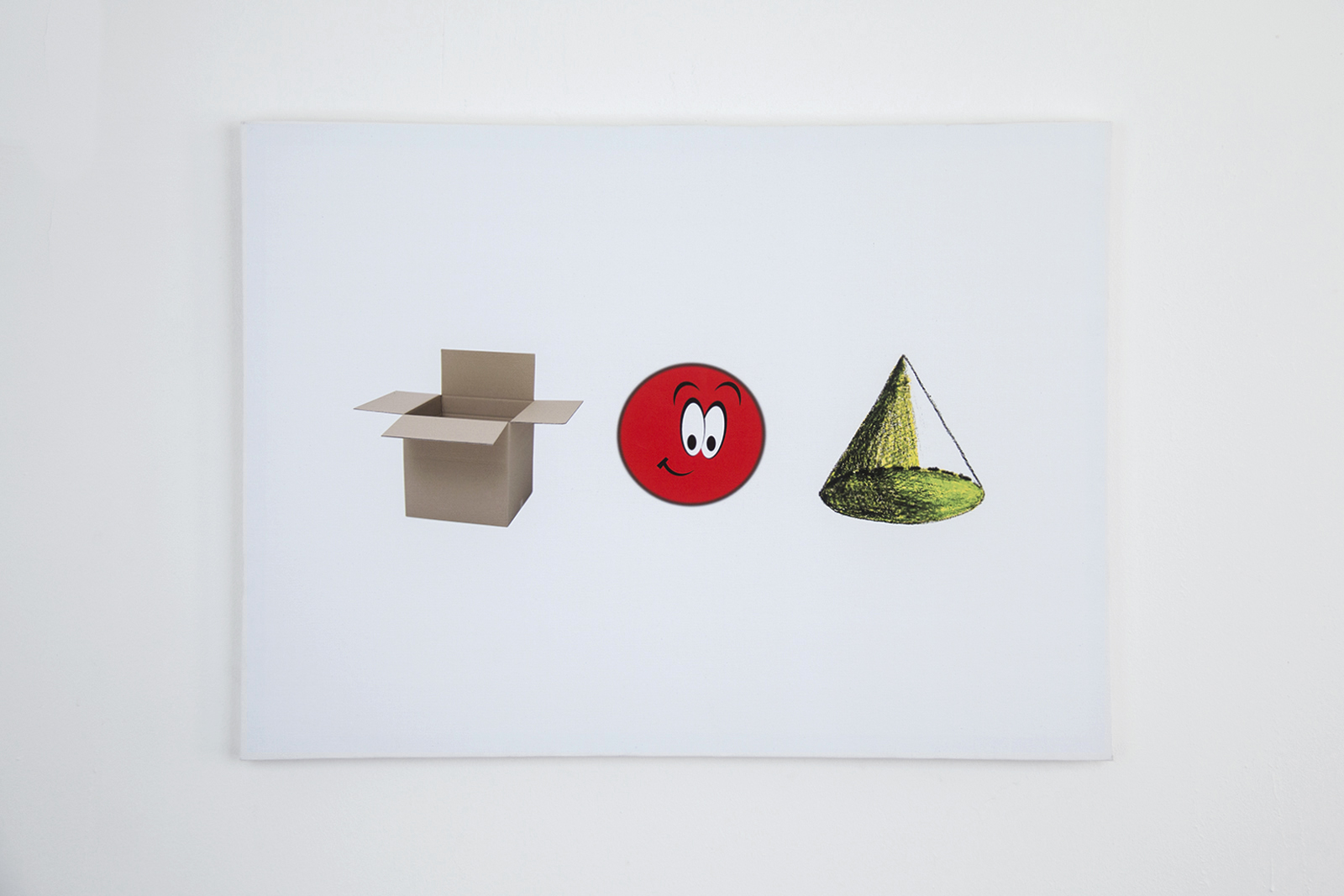 Bora Akinciturk & Berk Cakmakci
Bora Akinciturk & Berk Cakmakci
adaptation 2, 2017
unique inkjet print on canvas
50x70cm
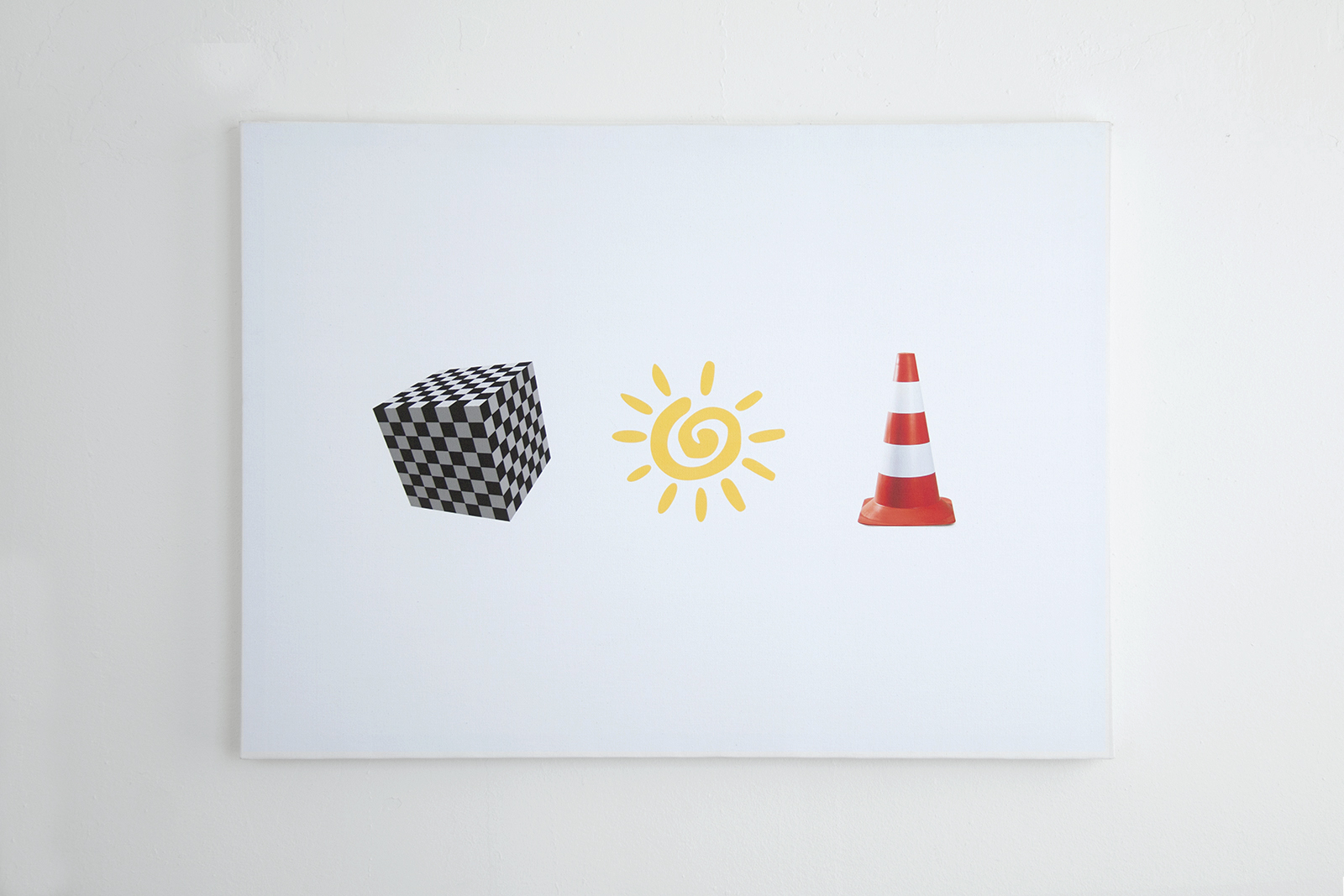 Bora Akinciturk & Berk Cakmakci
Bora Akinciturk & Berk Cakmakci
adaptation 3, 2017
unique inkjet print on canvas
50x70cm
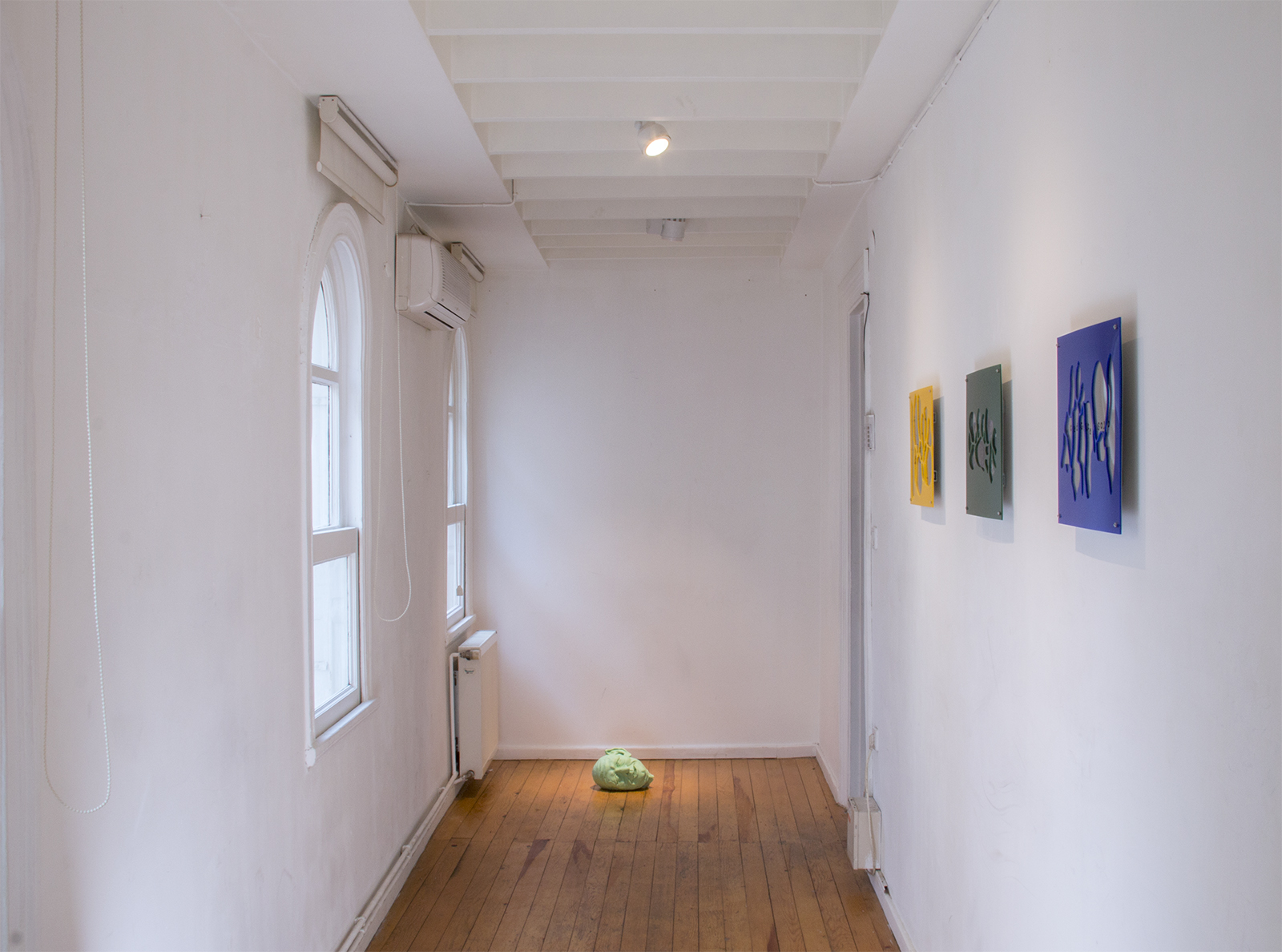 Installation view
Installation view
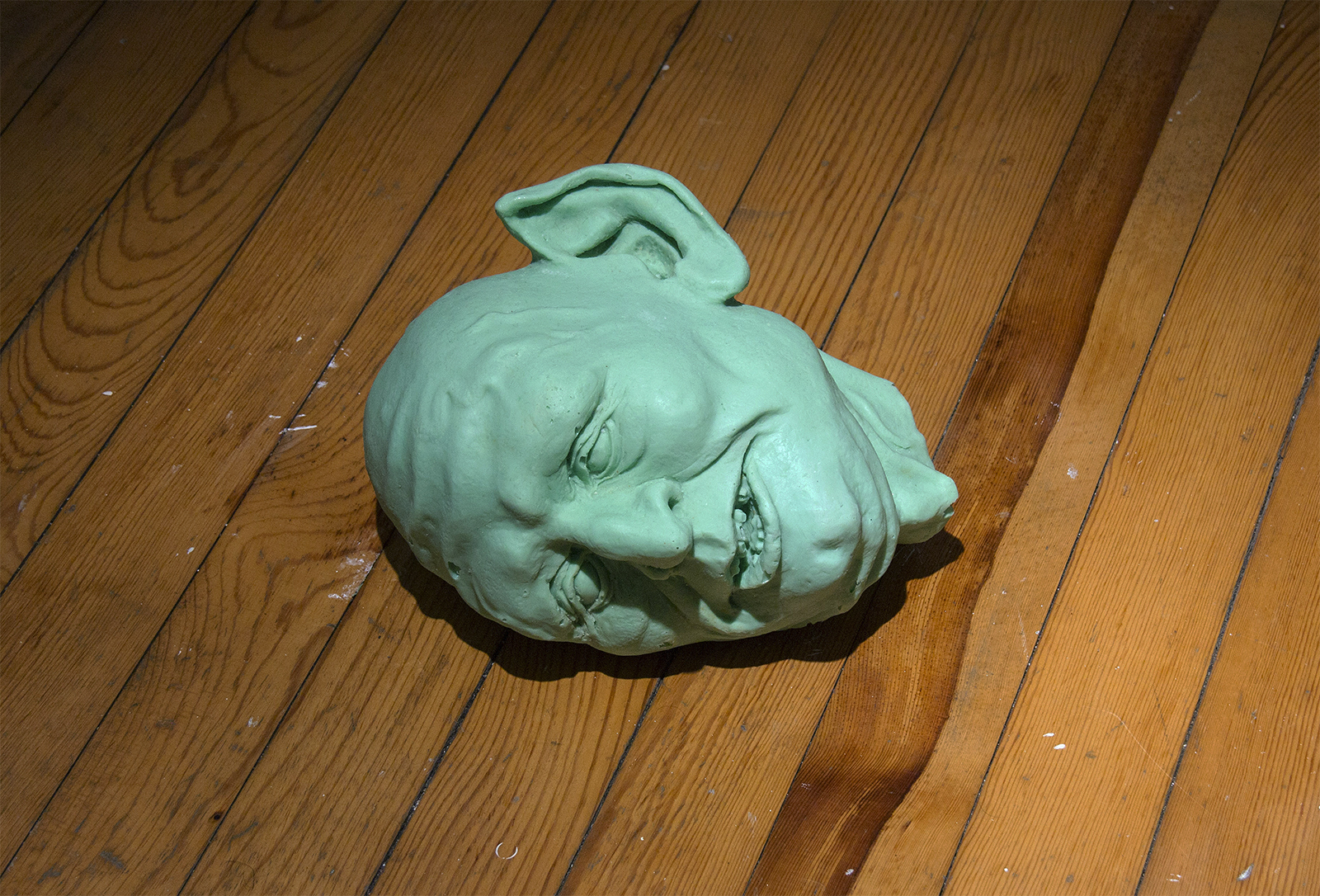 Bora Akinciturk & Berk Cakmakci
Bora Akinciturk & Berk Cakmakci
decapitated troll, 2017
silicone
30x20x16cm
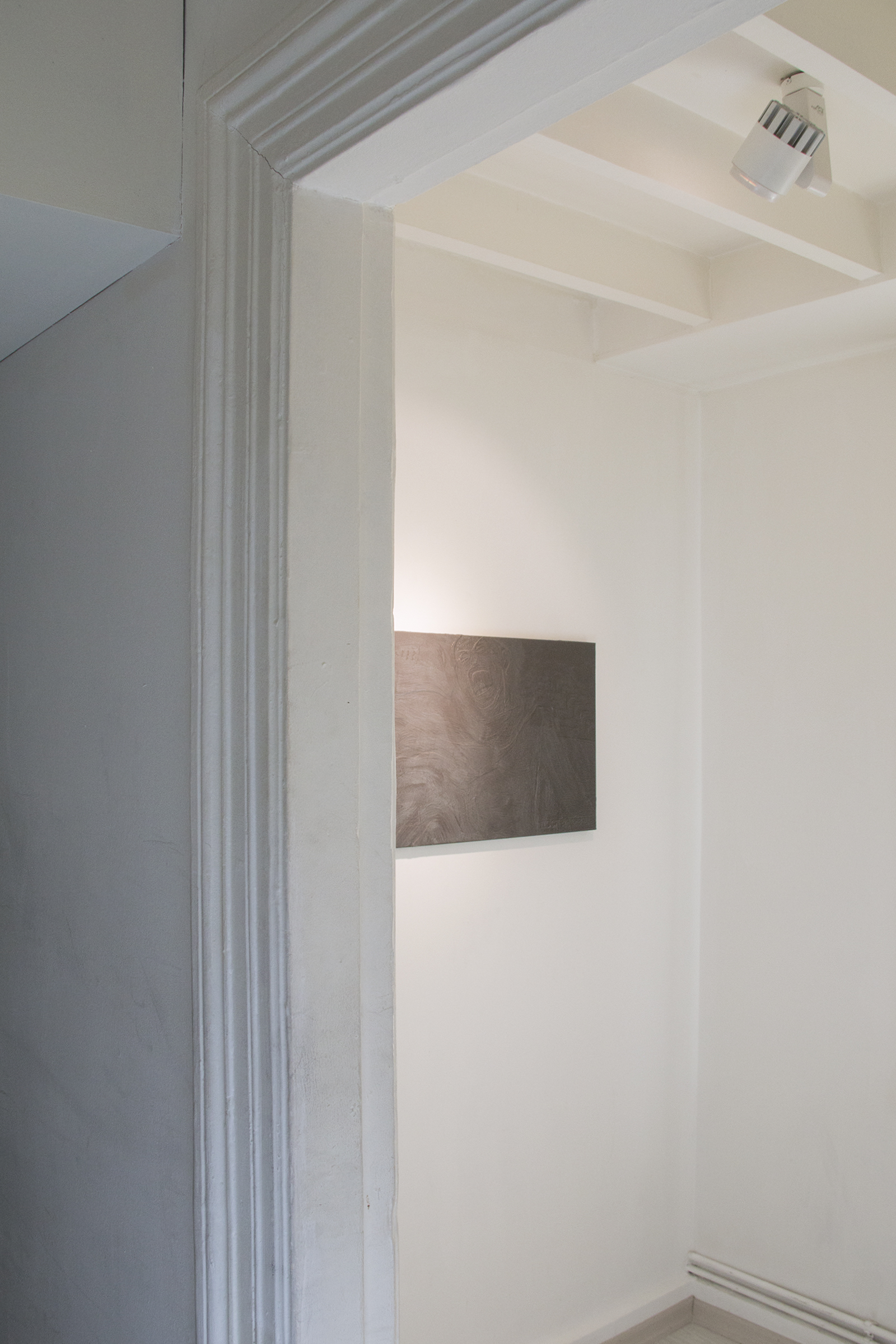 Installation view
Installation view
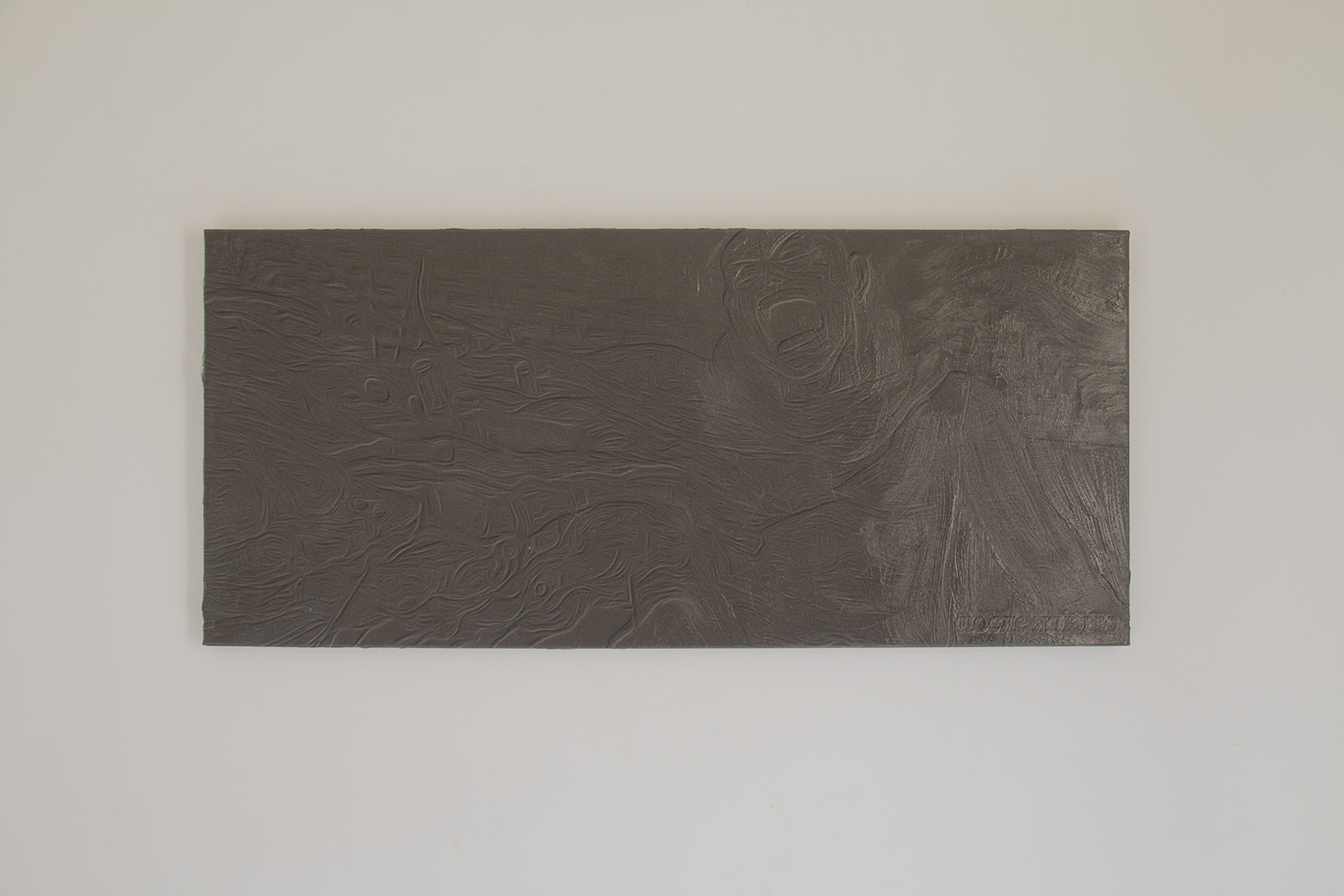 Bora Akinciturk & Berk Cakmakci
Bora Akinciturk & Berk Cakmakci
tetsuo (after life), 2017
acrylic, glossy gel medium and inkjet on canvas
45x100cm
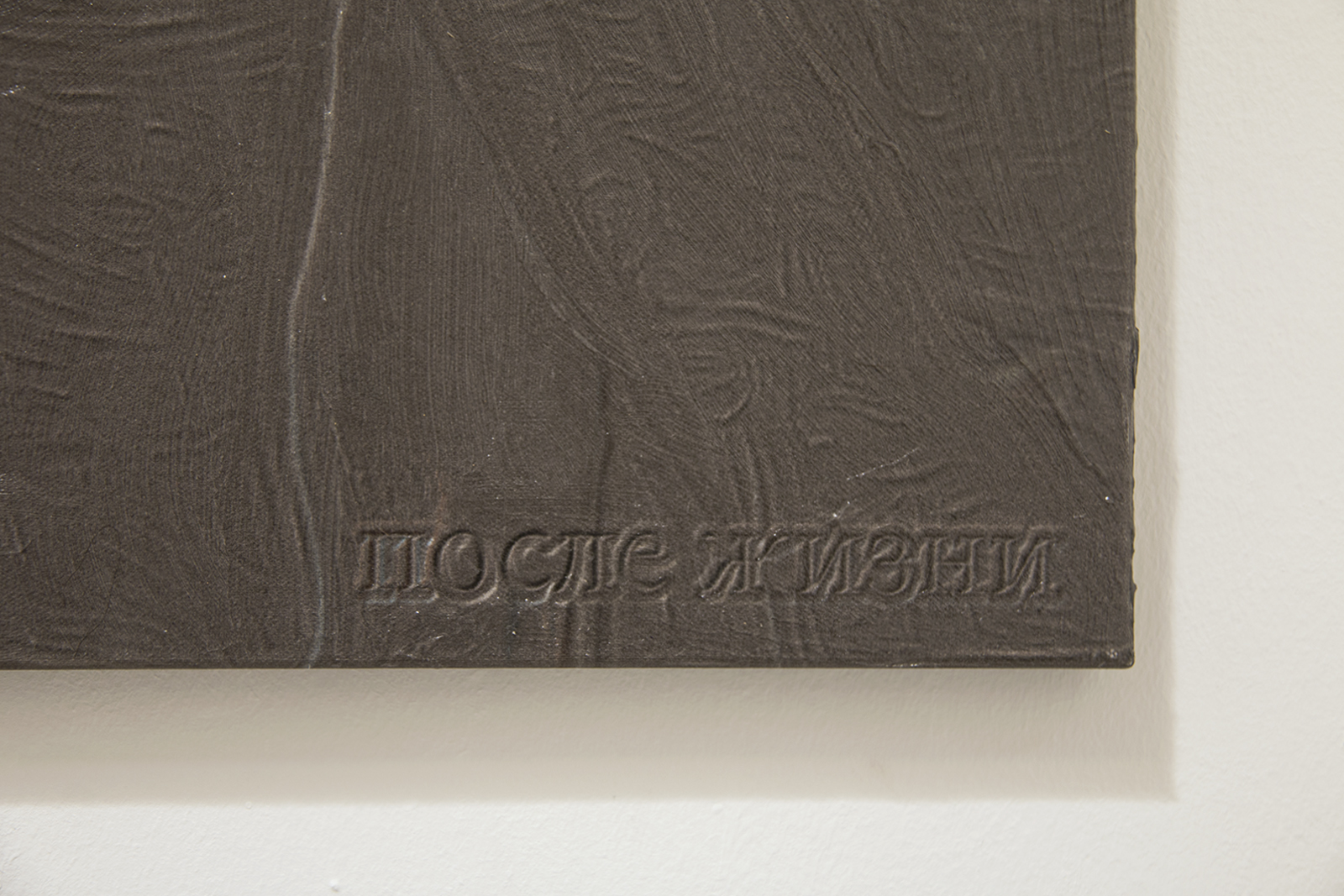 Bora Akinciturk & Berk Cakmakci
Bora Akinciturk & Berk Cakmakci
tetsuo (after life), detail
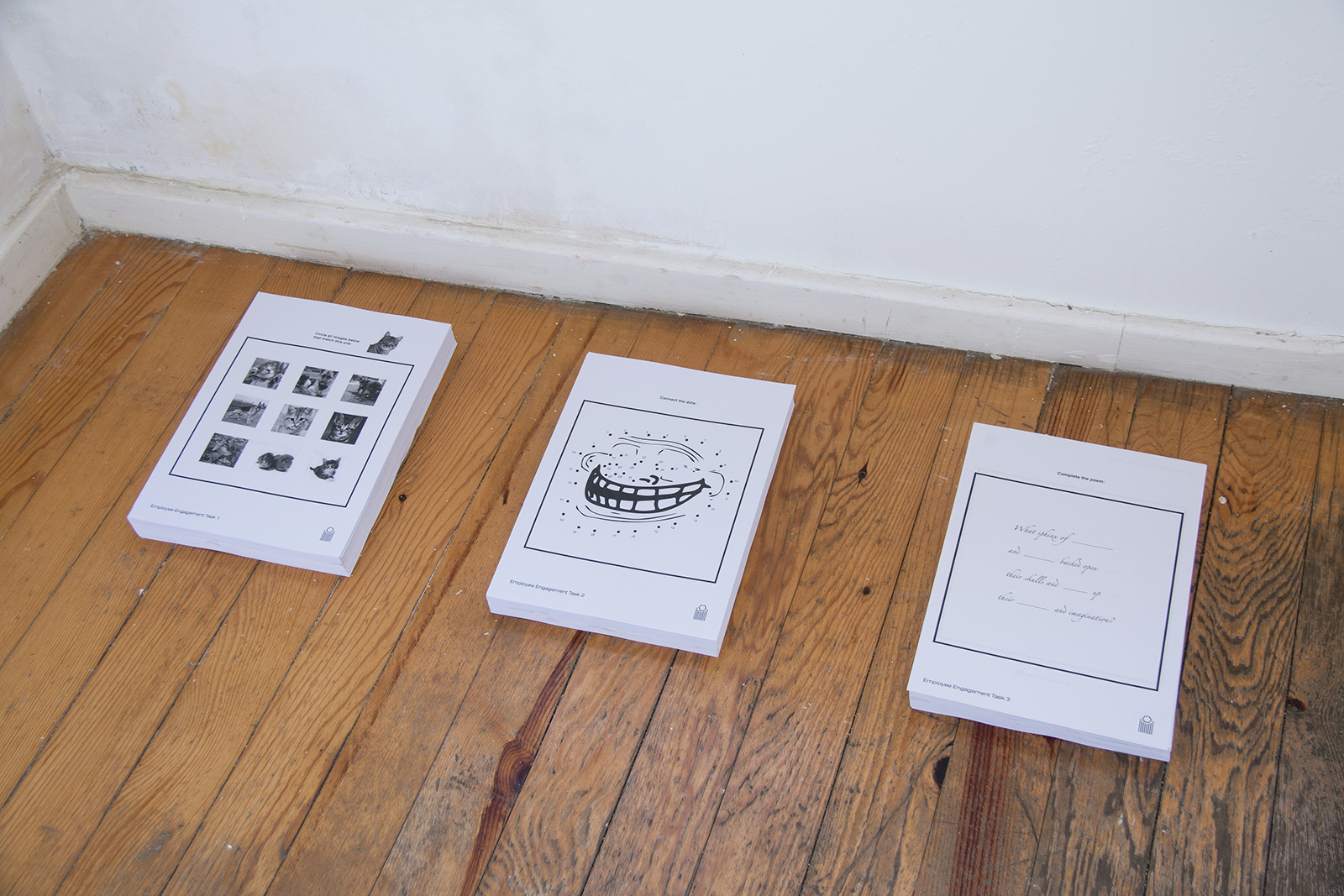 Employee Engagement Tasks, installation view
Employee Engagement Tasks, installation view
